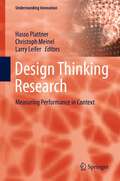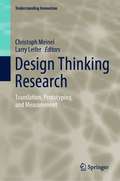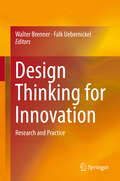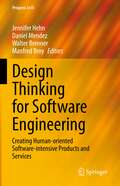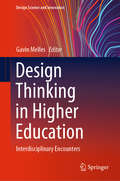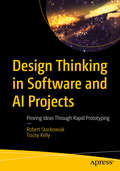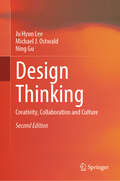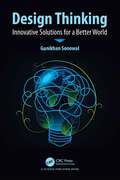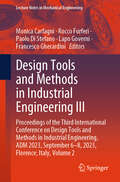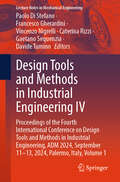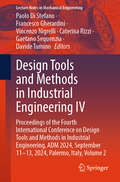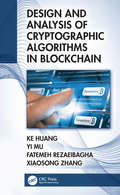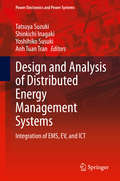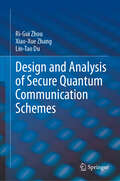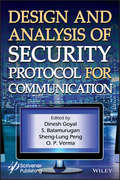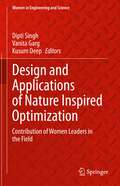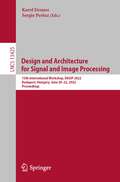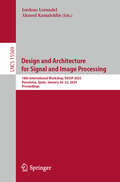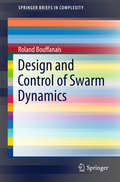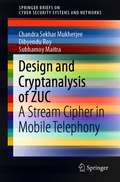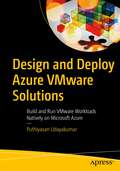- Table View
- List View
Design Thinking Research: Measuring Performance in Context
by Christoph Meinel Hasso Plattner Larry LeiferThis book summarizes the results of the third year in the Design Thinking Research Program, a joint venture of Stanford University in Palo Alto and the Hasso Plattner Institute in Potsdam. Understanding the evolution of innovation, and how to measure the performance of the design thinking teams behind innovations, is the central motivation behind the research work presented in this book. Addressing these fundamental concerns, all of the contributions in this volume report on different approaches and research efforts aimed at obtaining deeper insights into and a better understanding of how design thinking transpires. In highly creative ways, different experiments were conceived and undertaken with this goal in mind, and the results achieved were analyzed and discussed to shed new light on the focus areas. We hope that our readers enjoy this discourse on design thinking and its diverse impacts. Besides looking forward to receiving your critical feedback, we also hope that when reading these reports you too will get caught up in the fun our research teams had in carrying out the work they are based on: understanding innovation and how design thinking fosters it, which was the motivation for all the research work that is reported on in this book.
Design Thinking Research: Translation, Prototyping, and Measurement (Understanding Innovation)
by Christoph Meinel Larry LeiferExtensive research conducted by the Hasso Plattner Design Thinking Research Program at Stanford University in Palo Alto, California, USA, and the Hasso Plattner Institute in Potsdam, Germany, has yielded valuable insights on why and how design thinking works. The participating researchers have identified metrics, developed models, and conducted studies, which are featured in this book, and in the previous volumes of this series. This volume provides readers with tools to bridge the gap between research and practice in design thinking with varied real world examples. Several different approaches to design thinking are presented in this volume. Acquired frameworks are leveraged to understand design thinking team dynamics. The contributing authors lead the reader through new approaches and application fields and show that design thinking can tap the potential of digital technologies in a human-centered way. In a final section, new ideas in neurodesign at Stanford University and at Hasso Plattner Institute in Potsdam are elaborated upon thereby challenging the reader to consider newly developed methodologies and provide discussion of how these insights can be applied to various sectors. Special emphasis is placed on understanding the mechanisms underlying design thinking at the individual and team levels. Design thinking can be learned. It has a methodology that can be observed across multiple settings and accordingly, the reader can adopt new frameworks to modify and update existing practice. The research outcomes compiled in this book are intended to inform and provide inspiration for all those seeking to drive innovation – be they experienced design thinkers or newcomers.
Design Thinking for Innovation
by Falk Uebernickel Walter BrennerThis book presents the full scope of Design Thinking in theory and practice, bringing together prominent opinion leaders and experienced practitioners who share their insights, approaches and lessons learned. As Design Thinking is gaining popularity in the context of innovation and information management, the book elaborates the specific interpretations and meanings of the concept in different fields including engineering, management, and information technology. As such, it offers students and professionals a sourcebook revealing the power of Design Thinking, while providing academics a roadmap for further research.
Design Thinking for Software Engineering: Creating Human-oriented Software-intensive Products and Services (Progress in IS)
by Daniel Mendez Walter Brenner Manfred Broy Jennifer HehnThis book explores the possibility of integrating design thinking into today’s technical contexts. Despite the popularity of design thinking in research and practice, this area is still too often treated in isolation without a clear, consistent connection to the world of software development.The book presents design thinking approaches and experiences that can facilitate the development of software-intensive products and services. It argues that design thinking and related software engineering practices, including requirements engineering and user-centric design (UX) approaches, are not mutually exclusive. Rather, they provide complementary methods and tools for designing software-intensive systems with a human-centric approach.Bringing together prominent experts and practitioners to share their insights, approaches and experiences, the book sheds new light on the specific interpretations and meanings of design thinking in various fields such as engineering, management, and information technology. As such, it provides a framework for professionals to demonstrate the potential of design thinking for software development, while offering academic researchers a roadmap for further research.
Design Thinking in Higher Education: Interdisciplinary Encounters (Design Science and Innovation)
by Gavin MellesThis book addresses the contributions of design thinking to higher education and explores the benefits and challenges of design thinking discourses and practices in interdisciplinary contexts. With a particular focus on Australia, the USA and UK, the book examines the value and drawbacks of employing design thinking in different disciplines and contexts, and also considers its future.
Design Thinking in Software and AI Projects: Proving Ideas Through Rapid Prototyping
by Robert Stackowiak Tracey KellyLearn the fundamentals of Design Thinking and how to apply Design Thinking techniques in defining software development and AI solutions. Design Thinking is an approach to innovation which identifies problems and generates solution ideas that can be rapidly proven through prototyping.This book provides a brief history of Design Thinking and an overview of the process. It then drills down into more detail regarding methods and tools used in a Design Thinking workshops leading to useful prototypes. Guidance is provided on: Preparing for a Design Thinking Workshop Uncovering potential business problems that might be solvedPrioritizing potential solutionsIdentifying and characterizing stakeholdersChoosing the right prototypes for developmentLimiting scope and best practices in prototype buildingThe book concludes with a discussion of best practices in operationalizing successful prototypes, and describes change management techniques critical for successful adoption. You can use the knowledge gained from reading this book to incorporate Design Thinking techniques in your software development and AI projects, and assure timely and successful delivery of solutions.What You Will LearnGain foundational knowledge of what Design Thinking is and when to apply the techniqueDiscover preparation and facilitation techniques used in workshopsKnow how ideas are generated and then validated through prototypingUnderstand implementation best practices, including change management considerationsWho This Book Is ForBusiness decision makers and project stakeholders as well as IT project owners who seek a method leading to fast development of successful software and AI prototypes demonstrating real business value. Also for data scientists, developers, and systems integrators who are interested in facilitating or utilizing Design Thinking workshops to drive momentum behind potential software development and AI projects.
Design Thinking: Creativity, Collaboration and Culture
by Michael J. Ostwald Ning Gu Ju Hyun LeeThis book presents new ways of facilitating design thinking, through the combination of cognitive design strategies and information technologies. It provides readers with an in-depth understanding of the traditional and digital design processes and activities that are employed in architecture, computational design, communication design and graphic design. In response to evolving design practices, including the growing use of artificial intelligence (AI), this fully updated and expanded edition features a new chapter on digital design collaboration, along with extended discussions on the role of technology in shaping creative and collaborative processes. The book is divided into three parts: Part I, which focuses on creativity, uses evidence derived from empirical studies to develop an understanding of the way computational environments shape design thinking and may lead to more inventive outcomes. Part II considers the cognitive, sociotechnical dimensions of design teams, crowds and collectives. It investigates the ways digital design platforms promote interactive and collective thinking. Lastly, Part III addresses culture, examining the linguistic and cultural context of the globalised design ecosystem. Providing valuable insights into design thinking, this book helps readers engage with their local and global environments. It will appeal to academics, researchers and professionals with an interest in understanding design thinking in the context of creativity, collaboration and culture.
Design Thinking: Innovative Solutions for a Better World
by Gunikhan SonowalThe book serves as a reference manual in Design Thinking. It covers the history and development of design thinking, the fundamental ideas and procedures involved in design thinking, case studies of successful design thinking projects, and provides hints and tools for applying design thinking in diverse situations.In addition to giving readers the knowledge and skills necessary to implement design thinking in their own work, the book will assist readers to comprehend the importance of design thinking in problem-solving and creativity. It will also assist readers to overcome typical obstacles and achieve better results through design thinking by disseminating the knowledge and best practices of seasoned practitioners. Promoting the use of design thinking as a potent instrument for bringing about positive change in the world is the ultimate objective of the book.
Design Tools and Methods in Industrial Engineering II: Proceedings of the Second International Conference on Design Tools and Methods in Industrial Engineering, ADM 2021, September 9–10, 2021, Rome, Italy (Lecture Notes in Mechanical Engineering)
by Caterina Rizzi Francesco Gherardini Francesca Campana Michele Bici Tommaso Ingrassia Paolo CicconiThis book gathers original papers reporting on innovative methods and tools in design, modelling, simulation and optimization, and their applications in engineering design, manufacturing and other relevant industrial sectors. Topics span from advances in geometric modelling, applications of virtual reality, innovative strategies for product development and additive manufacturing, human factors and user-centered design, engineering design education and applications of engineering design methods in medical rehabilitation and cultural heritage. Chapters are based on contributions to the Second International Conference on Design Tools and Methods in Industrial Engineering, ADM 2021, held on September 9–10, 2021, in Rome, Italy, and organized by the Italian Association of Design Methods and Tools for Industrial Engineering, and Dipartimento di Ingegneria Meccanica e Aerospaziale of Sapienza Università di Roma, Italy. All in all, this book provides academics and professionals with a timely overview and extensive information on trends and technologies in industrial design and manufacturing.
Design Tools and Methods in Industrial Engineering III: Proceedings of the Third International Conference on Design Tools and Methods in Industrial Engineering, ADM 2023, September 6–8, 2023, Florence, Italy, Volume 1 (Lecture Notes in Mechanical Engineering)
by Francesco Gherardini Rocco Furferi Lapo Governi Paolo Di Stefano Monica CarfagniThis book gathers original peer-reviewed papers reporting on innovative methods and tools in design, modeling, simulation and optimization, and their applications in engineering design, manufacturing, and other relevant industrial sectors. Based on contributions to the Third International Conference on Design Tools and Methods in Industrial Engineering, ADM 2023, held on September 6–8, 2023, in Florence, Italy, and organized by the Italian Association of Design Methods and Tools for Industrial Engineering, and the Department of Industrial Engineering of the University of Florence, this first volume of a 2-volume set focuses on advances in design for additive manufacturing, engineering methods in medicine, user-centred design, and industrial design and ergonomics. Further topics include design for sustainability, engineering education, experimental methods for product development, and advanced methods for product and process design. This book provides academics and professionals with a timely overview and extensive information on trends and technologies in industrial design and manufacturing.
Design Tools and Methods in Industrial Engineering III: Proceedings of the Third International Conference on Design Tools and Methods in Industrial Engineering, ADM 2023, September 6–8, 2023, Florence, Italy, Volume 2 (Lecture Notes in Mechanical Engineering)
by Francesco Gherardini Rocco Furferi Lapo Governi Paolo Di Stefano Monica CarfagniThis book gathers original peer-reviewed papers reporting on innovative methods and tools in design, modeling, simulation and optimization, and their applications in engineering design, manufacturing, and other relevant industrial sectors. Based on contributions to the Third International Conference on Design Tools and Methods in Industrial Engineering, ADM 2023, held on September 6–8, 2023, in Florence, Italy, and organized by the Italian Association of Design Methods and Tools for Industrial Engineering, and the Department of Industrial Engineering of the University of Florence, this second volume of a 2-volume set focuses on interdisciplinary topics in design, such as human body acquisition and modelling, human factors and user-centered design, digital factories, and design methods for different engineering applications. All in all, this book provides academics and professionals with a timely overview and extensive information on trends and technologies in industrial design and manufacturing.
Design Tools and Methods in Industrial Engineering IV: Proceedings of the Fourth International Conference on Design Tools and Methods in Industrial Engineering, ADM 2024, September 11–13, 2024, Palermo, Italy, Volume 1 (Lecture Notes in Mechanical Engineering)
by Caterina Rizzi Vincenzo Nigrelli Francesco Gherardini Paolo Di Stefano Gaetano Sequenzia Davide TuminoThis book gathers original peer-reviewed papers reporting on innovative methods and tools in design, modeling, simulation and optimization, and their applications in engineering design, manufacturing, and other relevant industrial sectors. Based on contributions to the Fourth International Conference on Design Tools and Methods in Industrial Engineering, ADM 2024, held on September 11–13, 2024, in Palermo, Italy, and organized by the Italian Association of Design Methods and Tools for Industrial Engineering, and the Department of Engineering of the University of Palermo, this first volume of a 2-volume set focuses on advances in design for additive manufacturing, product design and engineering, design for sustainability and ecoDesign, experimental methods in product development and integrated methods for product and process design. Further topics include: simulation, analysis and optimization, design of collaborative and soft robots, geometrical product specification and tolerancing, and design methods for mobility. This book provides academics and professionals with a timely overview and extensive information on trends and technologies in industrial design and manufacturing.
Design Tools and Methods in Industrial Engineering IV: Proceedings of the Fourth International Conference on Design Tools and Methods in Industrial Engineering, ADM 2024, September 11–13, 2024, Palermo, Italy, Volume 2 (Lecture Notes in Mechanical Engineering)
by Caterina Rizzi Vincenzo Nigrelli Francesco Gherardini Paolo Di Stefano Gaetano Sequenzia Davide TuminoThis book gathers original peer-reviewed papers reporting on innovative methods and tools in design, modeling, simulation and optimization, and their applications in engineering design, manufacturing, and other relevant industrial sectors. Based on contributions to the Fourth International Conference on Design Tools and Methods in Industrial Engineering, ADM 2024, held on September 11–13, 2024, in Palermo, Italy, and organized by the Italian Association of Design Methods and Tools for Industrial Engineering, and the Department of Engineering of the University of Palermo, this second volume of a 2-volume set focuses on engineering methods in medicine, human factors and ergonomics, and reverse engineering. Further topics include: digital acquisition, image processing and inspection, virtual and augmented reality, virtual prototyping and digital twin, as well as engineering education, and knowledge and product data management. All in all, this book provides academics and professionals with a timely overview and extensive information on trends and technologies in industrial design and manufacturing.
Design Tools and Methods in Industrial Engineering: Proceedings of the International Conference on Design Tools and Methods in Industrial Engineering, ADM 2019, September 9–10, 2019, Modena, Italy (Lecture Notes in Mechanical Engineering)
by Caterina Rizzi Angelo Oreste Andrisano Francesco Leali Francesco Gherardini Fabio Pini Alberto VergnanoThis book reports on cutting-edge design methods and tools in industrial engineering, advanced findings in mechanics and material science, and relevant technological applications. Topics span from geometric modelling tools to applications of virtual/augmented reality, from interactive design to ergonomics, human factors research and reverse engineering. Further topics include integrated design and optimization methods, as well as experimental validation techniques for product, processes and systems development, such as additive manufacturing technologies. This book is based on the International Conference on Design Tools and Methods in Industrial Engineering, ADM 2019, held on September 9–10, 2019, in Modena, Italy, and organized by the Italian Association of Design Methods and Tools for Industrial Engineering, and the Department of Engineering “Enzo Ferrari” of the University of Modena and Reggio Emilia, Italy. It provides academics and professionals with a timely overview and extensive information on trends and technologies in industrial design and manufacturing.
Design and Analysis of Biomolecular Circuits
by Douglas Densmore Heinz Koeppl Gianluca Setti Mario Di BernardoThe book deals with engineering aspects of the two emerging and intertwined fields of synthetic and systems biology. Both fields hold promise to revolutionize the way molecular biology research is done, the way today's drug discovery works and the way bio-engineering is done. Both fields stress the importance of building and characterizing small bio-molecular networks in order to synthesize incrementally and understand large complex networks inside living cells. Reminiscent of computer-aided design (CAD) of electronic circuits, abstraction is believed to be the key concept to achieve this goal. It allows hiding the overwhelming complexity of cellular processes by encapsulating network parts into abstract modules. This book provides a unique perspective on how concepts and methods from CAD of electronic circuits can be leveraged to overcome complexity barrier perceived in synthetic and systems biology.
Design and Analysis of Cryptographic Algorithms in Blockchain
by Yi Mu Xiaosong Zhang Ke Huang Fatemeh RezaeibaghaThis book seeks to generalize techniques and experiences in designing and analyzing cryptographic schemes for blockchain. It devotes three chapters to review the background and basic knowledge, four chapters to discuss specific types of cryptographic primitive design for blockchain, one chapter to discuss optimization tools and another chapter for blockchain regulation and economies. This book covers the systematic survey of research objects, as well as detailed reviews of cryptographic schemes, lectures and methodologies to practice cryptography. The main findings of this book are summarized as following, first, the practical design and analysis of cryptographic schemes for blockchain can address major problems in blockchain at algorithmic level. Then, some intrinsic deficiencies in some traditional cryptographic primitives, like centralized setup, impractical design, etc, prevent the successful application of these primitives in blockchain. However, huge efforts are being made to make these primitives practical and applicable for researchers. Finally, the formal and rigorous design and analysis of public key cryptographic algorithms is vital to blockchain. Design and Analysis of Cryptographic Algorithms in Blockchain is a useful textbook for graduate students and PhD students, or researches who wish to connect cryptography with blockchain for research and developing projects.
Design and Analysis of Distributed Energy Management Systems: Integration of EMS, EV, and ICT (Power Electronics and Power Systems)
by Anh Tuan Tran Tatsuya Suzuki Shinkichi Inagaki Yoshihiko SusukiThis book provides key ideas for the design and analysis of complex energy management systems (EMS) for distributed power networks. Future distributed power networks will have strong coupling with (electrified) mobility and information-communication technology (ICT) and this book addresses recent challenges for electric vehicles in the EMS, and how to synthesize the distributed power network using ICT. This book not only describes theoretical developments but also shows many applications using test beds and provides an overview of cutting edge technologies by leading researchers in their corresponding fields. Describes design and analysis of energy management systems;Illustrates the synthesis of distributed energy management systems based on aggregation of local agents;Discusses dependability issues of the distributed EMS with emphasis on the verification scheme based on remote-operational hardware-in-the-loop (HIL) simulation and cybersecurity.
Design and Analysis of Secure Quantum Communication Schemes
by Ri-Gui Zhou Xiao-Xue Zhang Lin-Tao DuThis book provides a comprehensive guide to the design and analysis of quantum secure communication schemes. While quantum computers may provide a platform for arithmetic calculations which threaten classical cryptosystems, the development of quantum information has also brought a corresponding solution: quantum cryptography, which is the basis of quantum secure communication. Quantum secure communication (QSC) uses quantum states for key agreement and information transmission, and uses the basic principles of quantum mechanics to discover eavesdropping behavior, and to ensure the security of information. It can overcome the security risks of classical encryption technology and can securely distribute keys in real time via public channels. Beginning in 1984 with the first conception of quantum key distribution (QKD) based on single-photon polarization states, subsequent innovations include quantum identity authentication (QIA), quantum secret sharing (QSS), quantum direct communication (QDC), quantum key agreement (QKA), quantum private query (QPQ), and quantum network coding (QNC). Each of these schemes is explored in detail based on different environments and structures, along with specific security and feasibility analyses. This book is essential reading for academic researchers and graduate students in quantum science and technology, as well as professionals and engineers in quantum industries and cybersecurity.
Design and Analysis of Security Protocol for Communication
by Sheng-Lung Peng Dinesh Goyal S. Balamurugan O. P. VermaThe purpose of designing this book is to discuss and analyze security protocols available for communication. Objective is to discuss protocols across all layers of TCP/IP stack and also to discuss protocols independent to the stack. Authors will be aiming to identify the best set of security protocols for the similar applications and will also be identifying the drawbacks of existing protocols. The authors will be also suggesting new protocols if any.
Design and Applications of Nature Inspired Optimization: Contribution of Women Leaders in the Field (Women in Engineering and Science)
by Kusum Deep Dipti Singh Vanita GargThis book gives a detailed information of various real-life applications from various fields using nature inspired optimization techniques. These techniques are proven to be efficient and robust in many difficult problems in literature. The authors provide detailed information about real-life problems and how various nature inspired optimizations are applied to solve these problems. The authors discuss techniques such as Biogeography Based Optimization, Glow Swarm Optimization, Elephant herd Optimization Algorithm, Cuckoo Search Algorithm, Ant Colony Optimization, and Grey Wolf Optimization etc. These algorithms are applied to a wide range of problems from the field of engineering, finance, medicinal etc. As an important part of the Women in Science and Engineering book series, the work highlights the contribution of women leaders in nature inspired optimization, inspiring women and men, girls and boys to enter and apply themselves to the field.
Design and Architecture for Signal and Image Processing: 15th International Workshop, DASIP 2022, Budapest, Hungary, June 20–22, 2022, Proceedings (Lecture Notes in Computer Science #13425)
by Karol Desnos Sergio PertuzThis book constitutes the thoroughly refereed conference proceedings of the First International Workshop on Design and Architecture for Signal and Image Processing, DASIP 2022, held in Budaypest, Hungary in June 2022. The 13 full included in the volume were carefully reviewed and selected from 32 submissions. They are organized in the following topical sections: leading signal, image and video processing and machine learning in custom embedded, edge and cloud computing architectures and systems.
Design and Architecture for Signal and Image Processing: 18th International Workshop, DASIP 2025, Barcelona, Spain, January 20–22, 2025, Proceedings (Lecture Notes in Computer Science #15569)
by Jordane Lorandel Ahmed KamaleldinThis book constitutes the refereed conference proceedings of the 18th International Workshop on Design and Architecture for Signal and Image Processing, DASIP 2025, held in Barcelona, Spain, during January 20-22, 2025. The 10 full papers included in this book were carefully reviewed and selected from 23 submissions.They were organized in topical sections as follows: Specialized Hardware Architecture for Efficient Processing; Efficient Processing using AI for Image, Vision and Signal Applications, and Analysis of Emerging Techniques for Signal Processing Applications.
Design and Control of Swarm Dynamics
by Roland BouffanaisThe book is about the key elements required for designing, building and controlling effective artificial swarms comprised of multiple moving physical agents. Therefore this book presents the fundamentals of each of those key elements in the particular frame of dynamic swarming, specifically exposing the profound connections between these elements and establish some general design principles for swarming behaviors. This scientific endeavor requires an inter-disciplinary approach: biomimetic inspiration from ethology and ecology, study of social information flow, analysis of temporal and adaptive signaling network of interaction, considerations of control of networked real-time systems, and lastly, elements of complex adaptive dynamical systems. This book offers a completely new perspective on the scientific understanding of dynamic collective behaviors thanks to its multi-disciplinary approach and its focus on artificial swarm of physical agents. Two of the key problems in understanding the emergence of swarm intelligent behaviors are identifying the social interaction rules a. k. a. the behavioral algorithm and uncovering how information flows between swarming agents. While most books about swarm dynamics have been focusing on the former, this book emphasizes the much-less discussed topic of distributed information flow, always with the aim of establishing general design principles.
Design and Cryptanalysis of ZUC: A Stream Cipher in Mobile Telephony (SpringerBriefs on Cyber Security Systems and Networks)
by Subhamoy Maitra Chandra Sekhar Mukherjee Dibyendu RoyThis book is a timely document of state-of-the art analytical techniques in the domain of stream cipher design and analysis with a specific cipher, named ZUC. It links new research to brief contextual literature review in the domain of complex LFSR-based stream ciphers. A snapshot of how stream ciphers are deployed in the mobile telephony architecture, one of the most well-known topics for more than five decades in the domain of computer and communication sciences, is presented in this book. The book provides an in-depth study on design and cryptanalysis of ZUC as well as relevant research results in this field with directions towards future analysis of this cipher.
Design and Deploy Azure VMware Solutions: Build and Run VMware Workloads Natively on Microsoft Azure
by Puthiyavan UdayakumarLearn the essential design and deployment skills to utilize Azure VMware Solution to seamlessly move your VMware-based workloads from your datacenter to Azure and to integrate your VMware environment with Azure. This book will teach you how to manage your existing environments with the same VMware products you already know while modernizing your applications with Azure native services. Design and Deploy Azure VMware Solutions starts by reviewing Azure VMware essentials, followed by a walkthrough of the methods of preparing and expanding to Azure VMware Solution. Here, you will learn about the layers of Microsoft AVS, including the vSphere, vSAN, NSX-T, and assess and migrate on-prem VMware workloads to Azure VMware Solution using HCX. Further, you will understand how to deploy the desktop and learn Hosting Pool using Horizon on Microsoft Azure, a modern approach to managing and securing Horizon components. VMware Tanzu for modernizing applications in Azure and disaster recovery for VMware workloads in Azure is then discussed in detail. Finally, you will learn monitoring and operations management using the VMware vRealize Suite and see a demonstration of how to plan and deploy Infrastructure as a Service (IaaS) for Azure VMware Solution via vRealize Automation. After reading the book, you will be able to migrate or extend VMware workloads from on-premises to Azure without the need to re-architect applications or retool operations.What Will You Learn Get started with Azure VMware SolutionPrepare and plan to utilize Azure VMware SolutionDesign and deploy Azure VMware SolutionManage and secure Azure VMware Solution Who Is This Book For Azure VMware administrators and Azure Cloud Architects.
